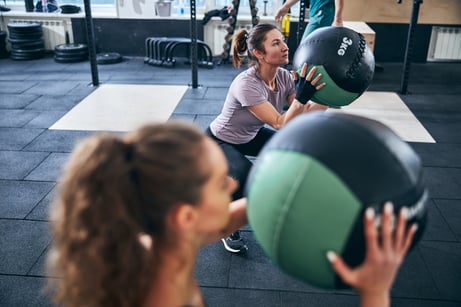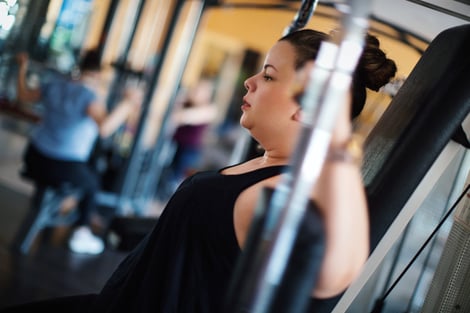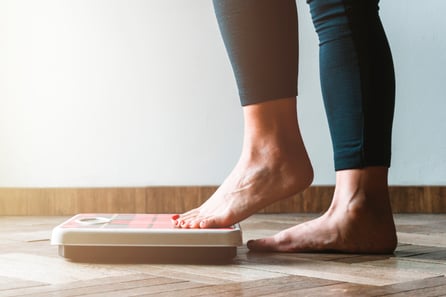 With the phrase “freshman 15” commonly tossed around, many students enter college with a fear or perception that they will gain weight. However, a meta-analysis of the available research showed that, while close to two thirds (60.9%) of first-year college students did gain weight, the average amount gained was only around 7.5 pounds. Of those who reported weight gain, only 10% gained 15 or more poundBased on these findings, not everyone experiences the “freshman 15”; however, it is evident that the majority of first-year college students do gain some weight. Increased stress levels, fewer hours of sleep, excess alcohol intake, and reduced physical activity are just some of the factors that may contribute to weight gain in college.
With the phrase “freshman 15” commonly tossed around, many students enter college with a fear or perception that they will gain weight. However, a meta-analysis of the available research showed that, while close to two thirds (60.9%) of first-year college students did gain weight, the average amount gained was only around 7.5 pounds. Of those who reported weight gain, only 10% gained 15 or more poundBased on these findings, not everyone experiences the “freshman 15”; however, it is evident that the majority of first-year college students do gain some weight. Increased stress levels, fewer hours of sleep, excess alcohol intake, and reduced physical activity are just some of the factors that may contribute to weight gain in college.
To prevent weight gain and maximize your overall health this semester, try some of the following suggestions:
Stick to a schedule.
College can wreak havoc on your preferred living, sleeping, and eating routines. It is important to establish a schedule and stick to it. Healthy habits to adopt include the following:
- Eating at least three well-rounded meals each day (and minimize late-night snacking).
- Going to bed and waking up around the same time each day.
- Drinking plenty of water (a general recommendation is at least 2–3 liters [64–96oz] each day).
- Getting between 7 and 9 hours of sleep each night.
Plan ahead and stock up on healthy staples.
A little preparation ahead of time will keep you from grabbing unhealthy snacks.
- Keep healthy snacks and staples in your dorm room or apartment. Some examples include the following: Microwavable brown rice, oatmeal, and popcorn; yogurt, apples, bananas, peanut butter, hummus, cheese sticks, granola, bagels, nuts, whole-grain crackers, cereal, and protein bars.
- Limit foods commonly consumed in college that are high in sodium and calories, such as ramen noodles, heavily buttered popcorn, and pizza.
- Keep a knife and cutting board on hand to slice fresh fruits and vegetables.
Limit high-sugar, high-calorie beverages.
Reduce intake of soda, energy drinks, sweetened coffees and teas, and alcohol. If you do choose to consume these beverages, be sure to drink in moderation and to factor them into your total caloric intake.
Don’t overdo it at the dining hall.
With limitless options, including plenty of not-so-healthy ones, making smart and healthy decisions at the dining hall can be complicated. To start, aim to pair a high-quality, lean protein source (chicken, fish, turkey, beans, yogurt, eggs, etc.) with a fruit or vegetable at each meal. Other tips include the following:
- Make use of the salad bar, if available, but be sure to limit high-caloric toppings such as nuts, seeds, cheeses, and dressings.
- Allow yourself some “treat foods,” but don’t make this a daily habit.
- Eliminate distractions while eating. Focus on the food you are eating, rather than your phone, laptop, or schoolwork.
Stay active.
Adults over 18 years of age should aim to get at least 150 minutes of moderate-intensity aerobic activity, such as brisk walking, and muscle-strengthening activities on two or more days each week. In order to meet these recommendations, make use of your school’s recreation center or gym, walk to class when possible, or participate in intramural sports. (Here are some more tips for staying fit in college.)
This blog was written by Lindsey Recker, MS, RD, NIFS Registered Dietitian. To learn more about the NIFS bloggers, click here.


 The month of October, also known as ROCKTOBER or SQUATOBER and famous for Halloween, is here. I thought I would put together two workouts—a fun workout, Pumpkin Partners, and a challenging workout, The Hell Bridge—that everyone can enjoy this October! Both are great for outdoor training in cooler weather
The month of October, also known as ROCKTOBER or SQUATOBER and famous for Halloween, is here. I thought I would put together two workouts—a fun workout, Pumpkin Partners, and a challenging workout, The Hell Bridge—that everyone can enjoy this October! Both are great for outdoor training in cooler weather Science News (August 9, 2021) reported a study released by the University of Kentucky College of Medicine and College of Health Sciences that adds to the growing evidence that resistance training has unique benefits for fat loss.
Science News (August 9, 2021) reported a study released by the University of Kentucky College of Medicine and College of Health Sciences that adds to the growing evidence that resistance training has unique benefits for fat loss.  Collagen is the most plentiful protein in the body and the primary structural component of connective tissues found in your bones, cartilage, tendons, ligaments and skin, aiding in their elasticity and strength. Our bodies naturally produce collagen; however, its production declines as we age, especially when paired with poor diet, excess alcohol use, lack of exercise, excess sun exposure, or use of tobacco products. The degradation of collagen and collagen production
Collagen is the most plentiful protein in the body and the primary structural component of connective tissues found in your bones, cartilage, tendons, ligaments and skin, aiding in their elasticity and strength. Our bodies naturally produce collagen; however, its production declines as we age, especially when paired with poor diet, excess alcohol use, lack of exercise, excess sun exposure, or use of tobacco products. The degradation of collagen and collagen production  We all know that core stability and strength is an important factor in exercise, athletics, and even daily living. Being able to properly brace and stiffen the core is an important skill in preventing lower-back injuries when attempting certain movement patterns that occur every day. The abdominal crunch, which people often think of as a core exercise, is actually not a movement we see in our day-to-day lives. Try and think of a time you have had to mimic the abdominal crunch under a heavy load: it simply does not occur.
We all know that core stability and strength is an important factor in exercise, athletics, and even daily living. Being able to properly brace and stiffen the core is an important skill in preventing lower-back injuries when attempting certain movement patterns that occur every day. The abdominal crunch, which people often think of as a core exercise, is actually not a movement we see in our day-to-day lives. Try and think of a time you have had to mimic the abdominal crunch under a heavy load: it simply does not occur.  When watching elite athletes during competition, there are many athletic traits and features that we novices or amateurs marvel at. We think to ourselves, “If I did something like that, I wouldn’t walk for a week!” Seeing an NFL running back or wide receiver make a cut at full speed, a baseball player hitting a 400-foot home run, or a powerlifter deadlifting the weight of a Volkswagen Beetle are feats that just leave you in awe.
When watching elite athletes during competition, there are many athletic traits and features that we novices or amateurs marvel at. We think to ourselves, “If I did something like that, I wouldn’t walk for a week!” Seeing an NFL running back or wide receiver make a cut at full speed, a baseball player hitting a 400-foot home run, or a powerlifter deadlifting the weight of a Volkswagen Beetle are feats that just leave you in awe.  It is estimated that there are almost 48 million cases of foodborne illness/food poisoning in the United States each year (source:
It is estimated that there are almost 48 million cases of foodborne illness/food poisoning in the United States each year (source:  According to the
According to the 